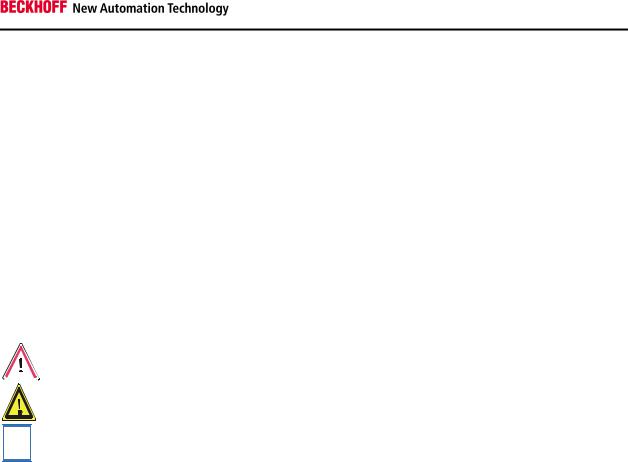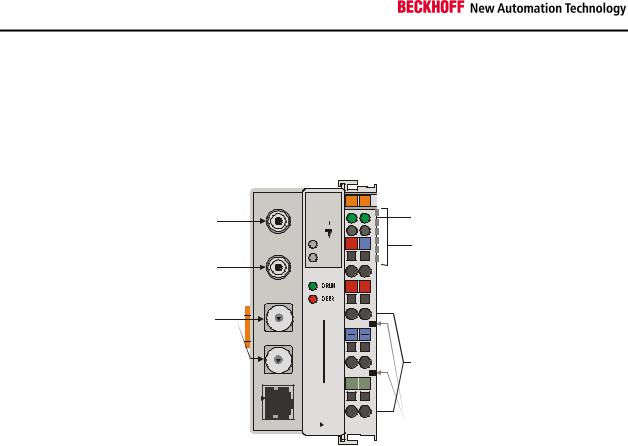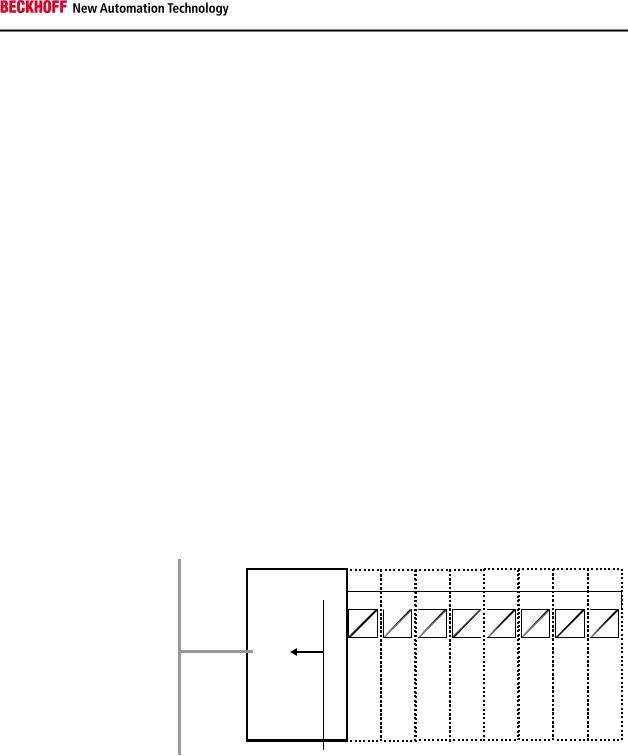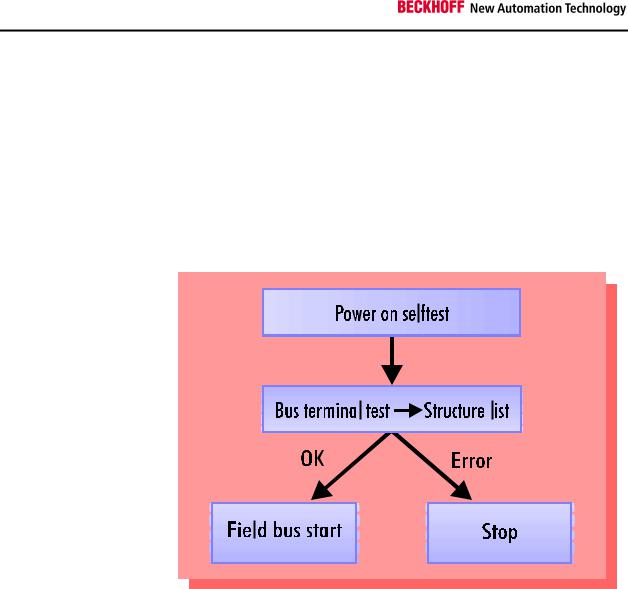BECKHOFF BK7000 User Manual

ControlNet Coupler
BK7000
Version: 0.9.1
Last change: 2006-10-30

Contents
Contents
1. Foreword |
2 |
Notes on the documentation |
2 |
Liability Conditions |
2 |
Delivery conditions |
2 |
Copyright |
2 |
Safety Instructions |
3 |
State at Delivery |
3 |
Description of safety symbols |
3 |
2. Basic information |
4 |
The Beckhoff bus terminal system |
4 |
The interfaces |
6 |
Power supply |
6 |
Power supply to the power contacts |
6 |
Power contacts |
6 |
Fieldbus connection |
6 |
Configuration interface |
7 |
K-bus contacts |
7 |
Supply isolation |
7 |
The operating modes |
8 |
Mechanical design |
9 |
Electrical data |
11 |
The peripheral data in the process image |
12 |
Starting operation and diagnostics |
14 |
Run times and reaction times |
16 |
3. ControlNet coupler BK7000 in the ControlNet |
17 |
Introducing the system |
17 |
The transfer medium: plugs and cables |
18 |
Configuring the master |
18 |
Config data of the Assembly object |
20 |
Calculating rules for terminal bus input and output data sizes |
21 |
Configuration with RS Networx 1.06 |
22 |
Save the configuration |
23 |
Configuration with RS Networx 1.03 |
23 |
4. Appendix |
24 |
Sample arrangement of a process image in the bus coupler |
24 |
Representation of analog signals in the process image |
26 |
5. Support and Service |
28 |
Beckhoff's branch offices and representatives |
28 |
Beckhoff Headquarters |
28 |
1 |
BK 7000 |

Foreword
Foreword
Notes on the documentation
This description is only intended for the use of trained specialists in control and automation engineering who are familiar with the applicable national standards. It is essential that the following notes and explanations are followed when installing and commissioning these components.
Liability Conditions
The responsible staff must ensure that the application or use of the products described satisfy all the requirements for safety, including all the relevant laws, regulations, guidelines and standards.
The documentation has been prepared with care. The products described are, however, constantly under development. For that reason the documentation is not in every case checked for consistency with performance data, standards or other characteristics. None of the statements of this manual represents a guarantee (Garantie) in the meaning of § 443 BGB of the German Civil Code or a statement about the contractually expected fitness for a particular purpose in the meaning of § 434 par. 1 sentence 1 BGB. In the event that it contains technical or editorial errors, we retain the right to make alterations at any time and without warning. No claims for the modification of products that have already been supplied may be made on the basis of the data, diagrams and descriptions in this documentation.
Delivery conditions
In addition, the general delivery conditions of the company Beckhoff Automation GmbH apply.
Copyright
© This documentation is copyrighted. Any reproduction or third party use of this publication, whether in whole or in part, without the written permission of Beckhoff Automation GmbH, is forbidden.
BK 7000 |
2 |

Foreword
Safety Instructions
State at Delivery
All the components are supplied in particular hardware and software configurations appropriate for the application. Modifications to hardware or software configurations other than those described in the documentation are not permitted, and nullify the liability of Beckhoff Automation GmbH.
Description of safety symbols
The following safety symbols are used in this documentation. They are intended to alert the reader to the associated safety instructions..
This symbol is intended to highlight risks for the life or health of personnel.
 Danger
Danger
This symbol is intended to highlight risks for equipment, materials or the environ-
ment.
Attention
This symbol indicates information that contributes to better understanding.
i Note
3 |
BK 7000 |

Basic information
Basic information
|
The Beckhoff bus terminal system |
|
The bus terminal system is the universal connecting link between a field- |
|
bus system and the sensor/actor level. A unit consists of a bus coupler, |
Up to 64 bus terminals |
which is the interface to the fieldbus, and up to 64 electronic terminals, of |
|
which the last is an end terminal. Terminals, each with two I/O channels, |
each with 2 I/O channels |
are available for any form of technical signal and can be combined as de- |
for any form of signal |
sired. The various types of terminal are all constructed in the same way, so |
|
that the planning costs are kept extremely low. The height and depth of the |
|
construction are calculated for compact terminal cabinets. |
|
Fieldbus technology makes it possible to use compact control architec- |
Decentralized wiring of the |
tures. The I/O level does not need to be taken right up to the control unit. |
I/O level |
Sensors and actors can be connected decentrally with minimal lengths of |
|
cable. You can position the control unit at any convenient location in the |
IPC as control unit |
installation. Using an industrial PC as control unit makes it possible to im- |
|
plement the operating and monitoring element as part of the control hard- |
|
ware, so the control unit can be located on an operating desk, control point |
|
or similar. The bus terminals constitute the decentralized input/output level |
|
of the control unit in the switch cabinet and its subordinate terminal cabi- |
|
nets. As well as the sensor/actor level, the power unit of the equipment is |
|
also controlled via the bus system. The bus terminal replaces a conven- |
|
tional terminal as the cabling level in the switch cabinet; the switch cabinet |
|
can be made smaller. |
Bus couplers for all current |
The Beckhoff bus terminal system combines the advantages of a bus sys- |
bus systems |
tem with the functionality of compact terminals. Bus terminals can be used |
|
on all current bus systems and serve to reduce the diversity of parts in the |
|
control unit, while behaving like the conventional standard units for the |
|
relevant bus system and supporting the entire range of functionality of the |
|
bus system. |
Standard C rail assembly |
The simple and compact assembly on a standard C rail, and the direct |
|
cabling of actors and sensors without cross connections between the ter- |
|
minals, serve to standardize the installation, as does the uniformly de- |
|
signed labeling. |
|
The small size and great flexibility of the bus terminal system mean that |
|
you can use it anywhere that you could use a terminal and use any type of |
|
connection – analog, digital, serial or direct sensors. |
Modularity |
The modular construction of the terminal row, using bus terminals with |
|
various functions, limits the number of unused channels to at most one per |
|
function. Two channels to a terminal is the optimum solution for the number |
|
of unused channels and the cost per channel. The possibility of using |
Display of channel status |
power input terminals to provide separate power supplies also helps to |
|
minimize the number of unused channels. |
|
The integrated light-emitting diodes close to the sensor/actor indicate the |
|
status of each channel. |
The K-bus |
The K-bus is the path taken by data within the terminal row. The bus cou- |
|
pler carries the K bus through all the terminals by means of six contacts on |
End terminal |
the side walls of the terminals, and the end terminal terminates the K bus. |
|
The user does not need to know anything about the function of the K bus |
|
or the internal operation of terminals and bus couplers. There are numer- |
|
ous software tools available which provide for convenient planning, con- |
|
figuration and operation. |
BK 7000 |
4 |

Basic information
Power input terminals Three power contacts pass the operating power to the following terminals. for You can use power input terminals to subdivide the terminal row as desired separately powered groups into groups, each with a separate power supply. These power input terminals are not taken into account for addressing the terminals, you can insert
them at any position along the terminal row.
You can install up to 64 terminals on a terminal row, including power input terminals and the end terminal.
The principle of the bus terminal
ControlNet |
Powersupply |
Potential |
|
bus coupler |
for the |
input |
Bus end |
BK7000 |
bus coupler |
terminal |
terminal |
|
|
Terminal bus |
|
x1
4 |
5 |
6 |
3 |
|
7 |
2 |
|
8 |
1 |
0 |
9 |
|
|
|
x10 |
||
4 |
5 |
6 |
3 |
|
7 |
2 |
|
8 |
1 |
0 |
9 |
|
|
|
ControlNet
 A
A 
 B
B
|
|
|
|
|
|
|
|
|
BECKHOFF |
BK7000 |
|
|
|
|
|
|
|
|
|
|
X0 |
00 |
24V
 0V
0V
+ 
 +
+
PE 
 PE
PE
|
|
|
|
Power |
Potential |
|
|
|
|
|
|
|
|
|
|
||
|
|
|
|
|
|
|
||
|
|
|
|
contacts |
isolation |
|
|
|
Bus couplers for various You can use a variety of bus couplers to attach the electronic terminal row fieldbus systems quickly and easily to the various fieldbus systems, and you can also subsequently convert to a different fieldbus system. The bus coupler deals with all the necessary monitoring and control tasks for operating the attached bus terminals, indeed all the operation and configuration of the bus terminals is carried out via the bus coupler. The fieldbus, K bus and I/O level are
electrically isolated.
If the exchange of data across the fieldbus is temporarily interrupted, logic states are preserved, digital outputs are cleared and analog outputs revert to a reset value which can be individually configured for each output when the equipment is set up.
5 |
BK 7000 |

Basic information
The interfaces
There are six ways of making a connection to a ControlNet bus coupler. These interfaces are designed as plug connections and spring terminals.
The ControlNet coupler
BK7000
Field Bus
Connector A
Field Bus
Connector B
Address
Selector
Network Access
Port (NAP)
Configuration
Interface
x1
4 |
5 |
6 |
3 |
|
7 |
2 |
|
8 |
1 |
0 |
9 |
|
|
x10
4 |
5 |
6 |
3 |
|
7 |
2 |
|
8 |
1 |
0 |
9 |
|
|
ControlNet
 A
A 
 B
B
|
|
|
|
|
|
|
|
|
|
|
|
BECKHOFF |
BK7000 |
|
|
|
|
|
|
|
|
|
|
X0 |
00 |
Power LEDs |
|
|
|
|
|
Bus coupler / power contacts |
24V |
0V |
Terminal bus |
|
Power supply bus coupler |
+ + |
24 V DC / GND |
Input
power contacts
PE 
 PE
PE


 power contacts
power contacts
|
Power supply |
24 V DC on the topmost |
The bus couplers need an operating power of 24 V DC which is connected |
terminals |
via the topmost spring terminals, labeled "24 V” and "0 V”. This power sup- |
|
ply serves not only the electronic components of the bus coupler but (via |
|
the K bus) also the bus terminals. The power supply of the bus coupler |
|
circuitry and that of the K-bus (Terminal bus) are electrically isolated from |
|
the voltage of the field level. |
|
Power supply to the power contacts |
Lower 3 terminal pairs for |
The six lower connections with spring terminals can be used to supply |
power input |
power to the peripherals. The spring terminals are connected in pairs to the |
|
power contacts. The power supply to the power contacts has no connec- |
|
tion to the power supply of the bus couplers. The power input is designed |
maximum 24 V |
to permit voltages up to 24 V. The pair-wise arrangement and the electrical |
|
connection between the feed terminal contacts makes it possible to loop |
|
through the wires connecting to different terminal points. The load on the |
maximum 10 A |
power contact may not continuously exceed 10 A. The current capacity |
|
between two spring terminals is the same as the capacity of the connecting |
|
wires. |
Power contacts
On the right-hand side face of the bus coupler are three spring contacts Spring contacts at the side which are the power connections. The spring contacts are recessed in slots to prevent them from being touched. When a bus terminal is connected, the blade contacts on the left-hand side of the bus terminal are connected to the spring contacts. The slot and key guides at the top and bottom of the bus couplers and bus terminals ensure reliable location of the power con-
tacts.
Control-Net connectors
BK 7000
Fieldbus connection
On the left-hand side there are two ControlNet connectors A and B and a NAP-Port. You will find a detailed description of the fieldbus interfaces in another part of this manual (In the chapter "The transfer medium: plugs and cables”).
6

Basic information
Configuration interface
On the lower part of the front face you will find the standard bus couplers
Serial interface under the which are fitted with an RS232 interface. The miniature plug can be at- |
||
front flap |
tached to a PC by means of a connection cable and the configuration soft- |
|
ware KS2000. This interface enables you to configure the analog channels. |
||
|
||
|
You can also access the functionality of the configuration interface via the |
|
|
fieldbus by means of the PLC interface communications. |
|
6 contacts at the side
3 supply groups: fieldbus
K-bus peripheral level
K-bus contacts
The connections between the bus coupler and the bus terminals are effected by gold contacts at the right-hand side of the bus coupler. When the bus terminals are plugged together, these gold contacts automatically complete the connection to the bus terminals. The K bus is responsible for the power supply to the electronic components of the K bus in the bus terminals, and for the exchange of data between the bus coupler and the bus terminals. Part of the data exchange takes place via a ring structure within the K bus. Disengaging the K bus, for example by pulling on one the bus terminals, will break this circuit so that data can no longer be exchanged. However, there are mechanisms in place which enable the bus coupler to locate the interruption and report it.
Supply isolation
The bus couplers operate with three independent supplies. The input power supplies the electrically isolated K-bus circuitry in the bus coupler and the K-bus itself. The power supply is also used to generate the operating power for the fieldbus.
Note: All the bus terminals are electrically isolated from the K bus, so that the K-bus is completely electrically isolated.
Bus coupler |
Bus terminals |
Setting up the power levels in the bus terminal system
 Terminal bus
Terminal bus
Field bus 

Periphery level
24 V DC
7 |
BK 7000 |

Basic information
The operating modes
When it is first switched on the bus coupler carries out a self-test to check the functions of its components and the communications of the K bus, and while this is going on the red I/O LED will flash. When the self-test has been completed successfully, the bus coupler will begin to test the attached bus terminals (the "bus terminal test”) and read in the configuration from which it constructs an internal structure list, which is not accessible from outside. If an error occurs the bus coupler will enter the operating mode "STOP”. If the start-up sequence is completed without errors the bus coupler will enter the mode "fieldbus start”.
Start-up behavior of the bus coupler
The bus coupler reports the error by means of the IO-ERR-LED. Clearing the error returns the bus coupler to its normal operating mode.
BK 7000 |
8 |
